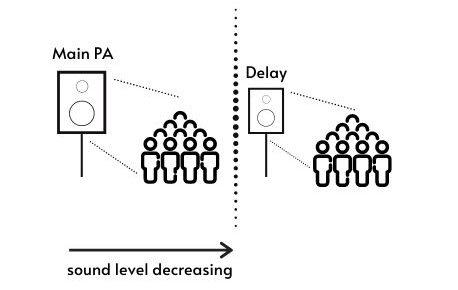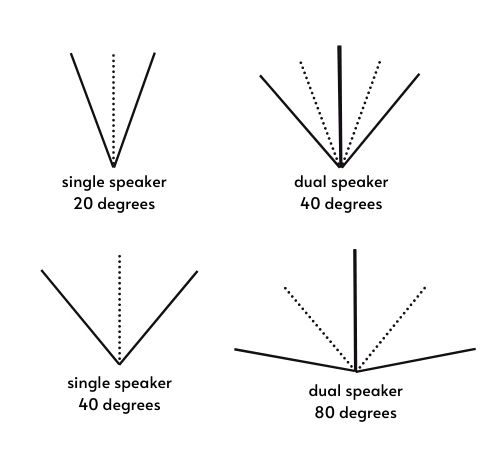Choosing the right PA system for your event can be confusing, it’s easy to feel overwhelmed with all the brands, models and specifications to consider. All we want is for artists to be heard and audiences to be wowed!
Today we hope to demystify loudspeakers and ultimately help you make the right choice when it comes to planning your next event.
What’s in the Box?
Whether we are looking to play background music for our friends and family or trying to communicate a live performance to a festival crowd, we rely on loudspeakers to (as the name suggests) make quiet things louder.
Loudspeakers come in many shapes and sizes, all designed to address various problems that we may encounter when planning an event. They consist of an enclosure or “box” (either wood or moulded plastic) and a combination of 2 or 3 “drivers” that physically drive the sound that we hear, with each driver designed to produce a certain range of sound.
Subs (sometimes called “bass” or “low” drivers) produce the lowest sounds we can hear; think of thumping kick drums and bass that you can feel in your body. Mid/lows produce the body of the music; think of the complex tone of a grand piano – most of this will be produced by a mid/low driver. Lastly; highs or “tweeters” produce the high end of sound we hear, think of sizzling hi hats and bright synths. All of these components work together to give us a complete picture of the audio we put into the loudspeaker.

If you are putting on a small event that has speech and some light music, a simple 2 way system with a mid/low and tweeter will work. However, if you are looking to put on a full band or DJ event you may want to think about adding some subs to your system.
Active or Passive?
When it comes to choosing the right loudspeaker, the way it takes power can be one of the biggest factors for you.
Active or “powered” speakers are those that have amplification built into the enclosure, sometimes with built in mixers and processing e.g. Turbosound iX12, iX15 and iQ15 are all examples of active loudspeakers that we stock. There are a few advantages of choosing an active loudspeaker:
- All-in-one solution
- Easy and quick to set up
- Lightweight
However they are not suited to all applications; they are generally not suitable for outdoor or wet weather and need to be set up close to a mains power supply. Remember each speaker needs both power and audio.
Passive or “unpowered” speakers are by description unpowered and require additional external amplification to work. This can mean extra work and knowledge when setting up passive systems, in addition to added weight and carry space.
However, passive systems generally work better outdoors and in wet environments since there is no mains electricity to the cabinets. They are also better suited to situations where the loudspeakers will be far away from the playback device – because there is only one cable to run from the central amplifier to the speaker. Passive speakers can also generally be linked together in pairs, allowing you to quickly and easily cover a larger audience.
You can view our range of passive loudspeakers here.
Watt Are You Talking About?
We are frequently dazzled by manufacturer power ratings, with each company trying to out-do the other:
“Our box is 5000W!”
– “Well ours is 10000W!”
Loudspeaker power ratings (watts) have been used by manufacturers to reduce the specifications of a loudspeaker to a single figure that can be easily understood by people. It has a rough correlation with loudness and is therefore useful for making assumptions about how loud a loudspeaker may be and to make comparisons between other loudspeakers.
Power rating is supplied as peak and RMS, with peak always being much higher than RMS. Manufacturers will often exploit this and display the peak value to make their product seem more attractive. Be aware of this as this does not reflect real world use – always refer to RMS power for a true sense of what the speaker is capable of delivering. We always display RMS power for our products.
A general rule of thumb is to budget 10W per person, allowing for more if you require a high sound pressure level or are putting on an outdoor show. For example a pair of Turbosound iX12s is 2000W RMS and is suitable for a small room of up to 200 people at moderate listening levels.
It is important to consider the differences in perceived loudness at various distances from the loudspeaker. As a rule, a doubling of distance from the speaker will result in a halving of loudness for the listener e.g. a person 10m away from the loudspeaker will experience half the loudness of a person 5m away. We can solve this issue by adding extra “delay” speakers to our system to ensure the entire audience experiences equal loudness, this is very common in larger venues or outdoor events.

Go Wide!
The final factor to consider is dispersion – simply put, this is how “wide” or “narrow” a loudspeaker is and informs how many loudspeakers we may need to use to cover our audience.
Dispersion is described in degrees both horizontally (left to right) and vertically (up and down). Loudspeakers are designed to have specific dispersion characteristics to direct the sound in a certain path. This is very useful for avoiding feedback from any microphones into the system and directing sound to a specific area but can limit us to the effective listening angle of our audience. Think of a speaker with narrow dispersion like pointing a laser beam – narrow and precise – whilst a wide dispersion is more like shining a torch – lighting up a much larger area.
For example if we take the Turbosound iX12 again – which has a dispersion of 80H (horizontal) and 60V (vertical). This means that we can effectively deliver sound to our audience +/- 40 degrees off centre (left to right) and +/- 30 degrees off centre (up and down). We need to make sure we position our speakers correctly so that we are covering our audience, think again of the torch analogy – will the audience be lit up or left in the dark?
If we need to cover a wider area, we may need to deploy a loudspeaker with a greater dispersion or use multiple loudspeakers to achieve equal listening for our audience.

To Summarise
When choosing the right loudspeaker system, ask yourself the following questions:
- Do I need an active or passive system?
- What frequency range do I need to cover? Do I need subs?
- How many people am I serving? How many watts do I need?
- How wide is my audience? Do I need high dispersion/multiple loudspeakers?
With these questions answered you will be armed with the knowledge that will help you make the right choice when it comes to deciding on a PA system. We hope you have found this article useful and can apply what has been learnt to make your event planning more effective.
We are always available to offer advice and assistance when it comes to choosing the right PA for you – get in touch with one of us here.
Thankyou!